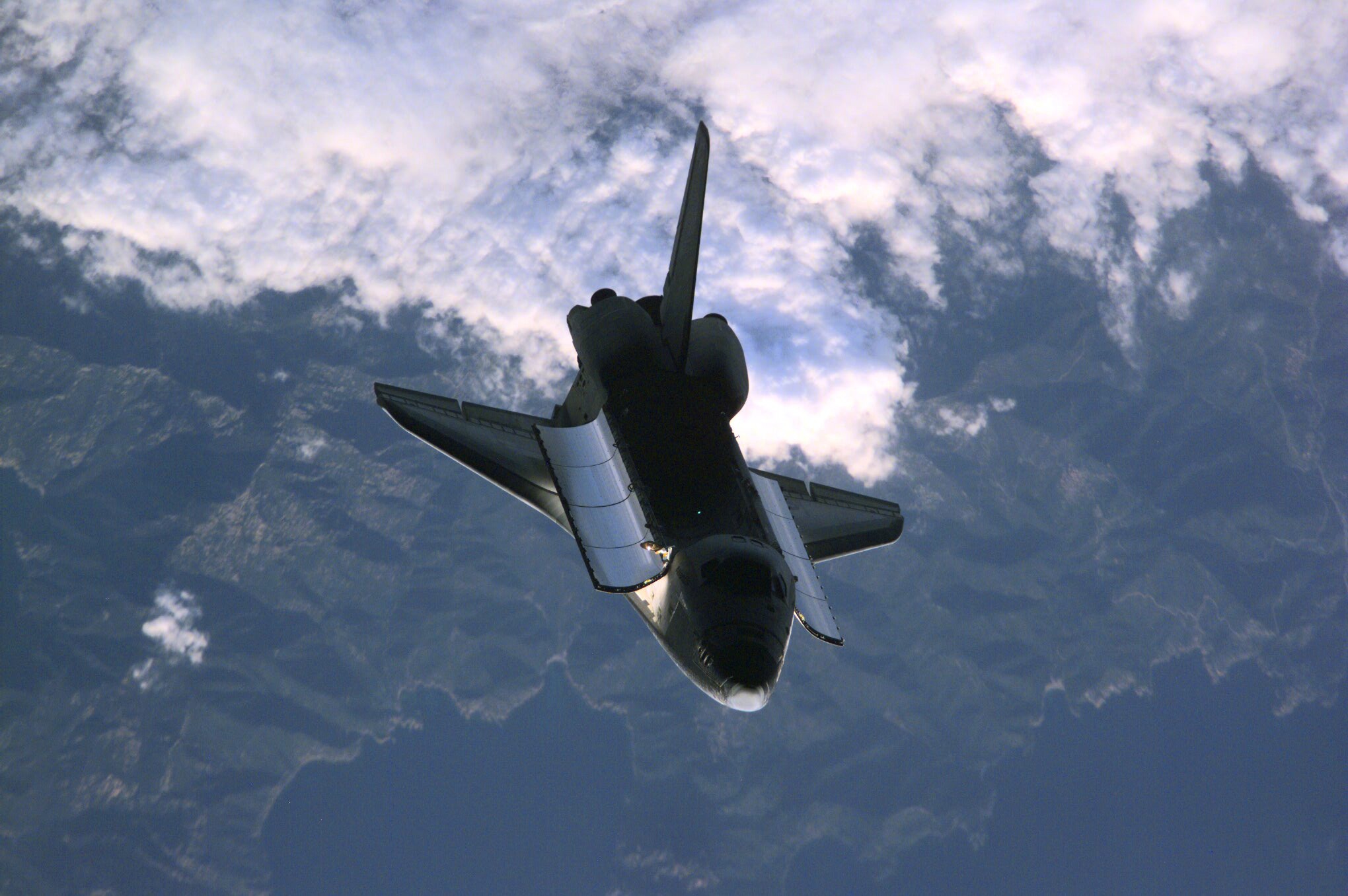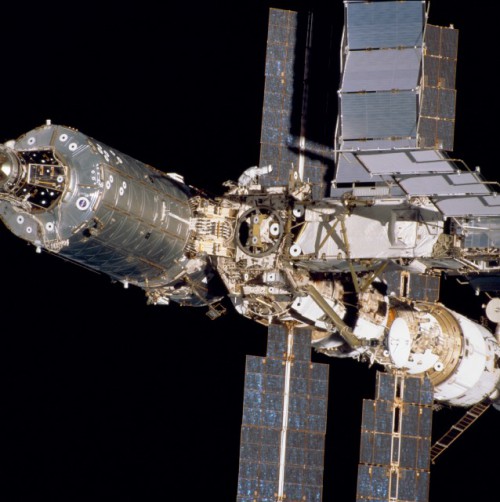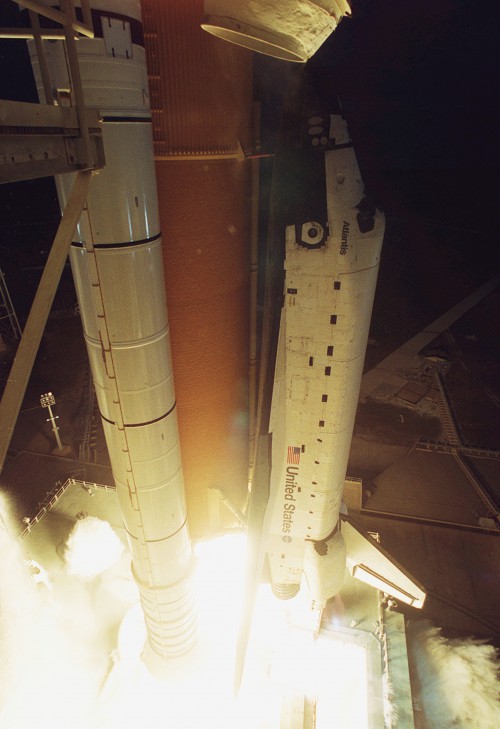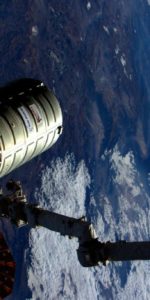
Fifteen years ago, today, on 20 February 2001, Space Shuttle Atlantis alighted on concrete Runway 22 at Edwards Air Force Base, Calif., closing out the 13-day STS-98 mission and a remarkable chapter in the construction of the International Space Station (ISS). Aboard the orbiter, Commander Ken Cockrell, Pilot Mark “Roman” Polansky, and Mission Specialists Bob Curbeam, Marsha Ivins, and Tom Jones had become the seventh group of humans to visit the infant station and had supported a trio of complex EVAs and an equally challenging series of robotics operations to install the Destiny laboratory module. As well as serving as the centerpiece of U.S. research aboard the ISS, Destiny would also provide the heart and brains of the station and evolve into a space-based National Laboratory.
Following then-President Ronald Reagan’s announcement of a permanent Space Station in January 1984, early conceptual designs envisaged two U.S. laboratory modules, although this was reduced to one following a major redesign in the months after the Challenger disaster. By August 1988, in the spirit of Reagan-era politics, the station received the name “Freedom,” and contracts to fabricate hardware were signed shortly thereafter. Under the language of the initial Space Station Intergovernmental Agreement (IGA)—which included the nations of the European Space Agency (ESA), the National Space Development Agency of Japan (NASDA), and the Canadian Space Agency (CSA)—about 97 percent of the lab’s resources would be allocated to NASA and the rest to Canada, in return for its contribution of robotic assets to the orbiting outpost.
Significant budgetary challenges plagued the Freedom program in the late 1980s, but by the spring of 1992 the U.S. lab was slated to arrive during the sixth shuttle assembly mission. Measuring 28 feet (8.5 meters) in length and 14.5 feet (4.4 meters) in diameter, its delivery would enable Man-Tended Capability (MTC) of Freedom and around half of its 24 internal racks would be devoted to research payloads, whilst the remainder would support Environmental Control and Life Support System (ECLSS), Thermal Control System (TCS), Electrical Power System (EPS), and other operational needs. “The lab is really the guts of the space station’s research and command and control capabilities,” Tom Jones told a NASA interviewer. “It becomes possible to do science and make the science quality science, because of the arrival of the lab.” Of course, the lab’s 14.5-foot (4.4-meter) diameter was dictated and restrained by the width of the shuttle’s payload bay. Following the extensive redesign of Freedom—and its eventual rebirth as the International Space Station—the fabrication of the lab’s main structure was completed by prime contractor Boeing in September 1995, with a targeted launch date in the fall of 1998.

It then underwent machining for various functions, including the drilling of holes for hatch seals and berthing mechanisms, followed by the installation of Micrometeroid Orbital Debris (MMOD) shield blankets and various mechanical systems, ahead of pressure testing and painting. By the late spring of 1997, delays to the program had pushed the first launch of ISS hardware to no sooner than July 1998, which in turn pushed the U.S. lab about six months downstream. According to Tom Jones, in his memoir, Sky Walking, veteran astronaut Mark Lee—who had spacewalked on the first untethered demo of the Simplified Aid for EVA Rescue (SAFER) backpack and at the Hubble Space Telescope (HST)—approached him in the spring of 1997 to participate in underwater tests in the Neutral Buoyancy Laboratory (NBL), just to the north of the Johnson Space Center (JSC) in Houston, Texas. “I didn’t want to get my hopes up,” Jones wrote, “but Mark seemed to be carrying around some good news, although he was not quite certain how to share it.”
Early in June 1997, NASA announced Lee and Jones to begin training for three spacewalks to install the lab on shuttle mission STS-98, then planned for launch no earlier than May 1999. The lab would be installed at the aft “end” of the Unity node, necessitating the robotic removal of Pressurized Mating Adapter (PMA)-2 from this interface. Initial plans, crystallized by Lead EVA Officer Kerri Knotts, envisaged Lee and Jones wiring up the lab’s backup heaters to keep its electronics warm during the bitter orbital nighttime, then hooking up power, data, and cooling umbilicals, together with a grapple fixture for the subsequent installation of the Canadarm2 robotic arm. Finally, the spacewalkers would assist in the robotic relocation of PMA-2 to its new location at the forward end of the newly-installed lab. “The EVAs were central to the success of the mission,” Jones wrote. “If we failed to get the job done, the lab could be irreparably damaged and the space station’s future research and control capabilities seriously degraded.”
Yet the delays—particularly in relation to Russia’s Zvezda service module—continued, with the launch of the first station elements postponed until the end of 1998. This correspondingly pushed the flight of STS-98 and the lab until no earlier than October 1999. In anticipation of this revised schedule, in August 1998 NASA assigned Ken Cockrell, Mark Polansky, and Marsha Ivins to round out the STS-98 crew, with the expectation that the Expedition 1 increment of Commander Bill Shepherd and his Russian comrades Yuri Gidzenko and Sergei Krikalev would be aboard the ISS for the lab’s installation. Within weeks, however, the Russian financial collapse factored into the late delivery of Zvezda, and STS-98 was pushed until no sooner than January 2000. As circumstances transpired, the service module did not rise to orbit and dock at the ISS until July 2000, which shoved each successive shuttle assembly mission further downstream and moved STS-98 to no sooner than January 2001.
Although Zvezda’s eventual arrival “would break the assembly logjam and kick off a series of major construction milestones,” according to Jones, the makeup of his crew had also changed significantly. In September 1999, it was revealed that Mark Lee had been removed from the STS-98 crew, for undetermined reasons. In Sky Walking, Jones expressed intense disappointment over the decision—Lee’s “leadership and hard work” in preparing for the mission, he wrote, “had been not only superlative but, to me, indispensable”—and the crew’s efforts to win a review of the situation from the Office of Space Flight at NASA Headquarters in Washington, D.C., were fruitless. Lee was replaced by veteran astronaut Bob Curbeam, who had himself been in training for more than two years in support of another ISS construction mission. “Beamer and I had never worked together,” Jones recalled, with their respective duties and previous missions having “kept us from being more than nodding acquaintances,” although Curbeam blended seamlessly into the crew. In fact, it was Curbeam who proposed attaching the main power and cooling umbilicals onto Destiny during the first EVA, thereby pushing the lab’s activation two days earlier than planned.

As a consequence, Jones now assumed the role of “EV1,” the chief spacewalker, for STS-98 and as launch neared he and Curbeam averaged about 200 hours performed underwater training in the NBL. And with the resumption of ISS construction activity on the STS-92 and STS-97 missions in the fall of 2000—together with the arrival of the Expedition 1 crew to begin the permanent occupation of the outpost—the stage was set for the arrival of the U.S. lab, which had by now received the name “Destiny.” Originally targeted to launch on 18 January 2001, the need to resolve a problem associated with the separation ordnance of the left-hand Solid Rocket Booster (SRB) delayed the rollout from the Vehicle Assembly Building (VAB) to Pad 39A. The wiring was X-rayed and revealed crumbling electrical cable shielding, which was repaired without the need to de-stack the vehicle, but postponed the launch until later in January. At length, after also weathering a computer malfunction within the Mobile Launch Platform (MLP), the shuttle arrived at Pad 39A on the 3rd. Unfortunately, more trouble was afoot, as assessments of the SRB separation ordnance issue prompted a decision to roll the stack back to the VAB for testing to confirm the health of the wiring. This pushed the launch to early February, with managers eventually settling on the 7th.
Liftoff occurred a few minutes after local sunset, at 6:13 p.m. EST—coincidentally on the Expedition 1 crew’s 100th day in space—and lit up the darkened Florida sky as Atlantis speared for the heavens on a two-day chase of the space station. “Atlantis surged upward, the bag and rattle settling into a more tolerable, yet still pronounced shaking,” Jones wrote in Sky Walking. “Atlantis began to rotate onto the proper track to chase the ISS up the East Coast. I felt the orbiter pirouette gracefully, swing past the mark, then gently correct the overshoot. Heads down now, we arced over the Atlantic; my body slid tightly against my shoulder straps and stayed there.” Riding the “full-throated scream” of the SRBs for the first two minutes, the stack also endured the “rising howl” of the slipstream passing Atlantis’ walls and the “pulsing vibration” of the shuttle’s three main engines, before the five astronauts achieved their initial orbit just 8.5 minutes after departing the Cape.
Shortly after orbital insertion, the crew opened the payload bay doors, unfurled the Ku-band antenna, and conducted checkouts of the Canadian-built Remote Manipulator System (RMS) mechanical arm and tests of the Extravehicular Mobility Units (EMUs) which Jones and Curbeam would use for their trio of EVAs. Despite evidence of a possible oxygen leak in a third, spare EMU (which ultimately proved erroneous), the suits checked out satisfactorily.
Throughout the first two days, Cockrell and Polansky executed a series of rendezvous “burns” to draw closer to the space station and by the early hours of 9 February the pilots pressed into their final procedures as Atlantis reached just 9 miles (15 km) from its destination. At 11:51 a.m. EST, Cockrell performed a smooth docking at the Pressurized Mating Adapter (PMA)-3 interface, located at the Earth-facing (or “nadir”) port of the Unity node. This was the second such docking at PMA-3, and Cockrell was required to adopt a “tail-forward” attitude—with Atlantis’ nose directed along the station’s long axis—thereby creating the proper conditions for the installation of Destiny. Shortly after the completion of customary pressure and leak checks, the hatches between the station and the shuttle were opened for a few hours of greetings between the two crews, then closed again, to prepare for the first EVA.
America’s Destiny was almost ready for business.
The second part of this article will appear tomorrow.
Be sure to “Like” AmericaSpace on Facebook and follow us on Twitter: @AmericaSpace






The Space Shuttle would have been the ultimate spy plane by staying in orbit for 4 to 6 months at a time. Solar panels and extra environmental pallets were all that were needed. The only problem was that due to debilitation either a new pilot would have to be brought up with another shuttle or the craft landed by remote control (possibly using an operator in a chase plane for the final approach).
There was never any need for a space station.
If a cargo version (the shuttle C) had been available it might have been possible to modify External Tanks as workshops and build a small city in LEO with them. But as a make work jobs program the ISS at 100 billion plus over more than ten years of construction time has no equal. Ironically the NewSpace mob, which screams incessant bloody murder over such “waste”, has not a single bad thing to say about the space station to nowhere. That their flagship company would not exist without NASA corporate welfare has something to do with that I think.
Conway Costigan, a few comments to add to yours. I was part of the Shuttle-C studies as a young engineer. The economic case was never there. Each flight of Shuttle-C threw away three main engines, their main engine controllers, all of the aft fuselage propulsion, pneumatic, hydraulic, and the hydrazine auxiliary power equipment. Also lost on each mission was the full suite of multiplexers-demultiplexes and computers, transmitters and receivers needed to make the system fly. I haven’t even addressed the airframe structure, payload retention latches, wiring, batteries for power and the power distribution and control switching equipment.
Where the Orbiter was fully reusable each Shuttle-C was fully expendable.
As for outfitting the external tanks in orbit as habitats for space station… Anything can be done. At what cost and risk? My key point is that Space Station Freedom was cancelled due to the time and cost of assembly due to the total amount of spacewalk hours needed and the associated risk of crews being outside hanging a spacesuit malfunction or a hyper velocity space debris impact from paint flakes, other man-made objects or natural dust grains. The pre-integrated truss space station design moved all the structural assembly, electrical, data, and plumbing installation, secondary bracketry attachment, subsystem component and “black box” installation and testing to the ground. The advantages were many: more than just two workers, plus the change to a shirt sleeve, 1-g, three shift a day operation if needed with all the food, water and potty breaks needed, whenever needed.
Working inside a cryogenic hydrogen tank with possibly explosive vapors or frozen chunks of shock sensitive ice and having to make it safe would be a challenge. The aft “man hole cover” hatch was the only access to the hydrogen tank. I don’t know if a space side astronaut could fit through. Inside were baffles to control fluid slush, sensors to detect fluid level, and feed lines where collected fuel was sent to the three engines. I suspect there were plenty of sharp edges that could cut a spacesuit. Not good.
ASSUMING all of ET interior was left in place, all of the equipment needed to outfit the inside would have to fit through that approx 1-2 meter diameter aft “man hole”. And there are three Space Station Freedom issues of cost, time, EVA risk to run all the utilities and build up and test all the systems. Cutting more and bigger holes in the ET hydrogen tank would modify its load bearing capability, particularly is ability to contain a 14.7 psi O2-N2 atmosphere for the crew.
Once we make an empty hydrogen tank livable (environmental and crew systems) we need to make it a spaceship… Command, communication, internet, TV, telemetry, propulsion, power, guidance, navigation, & control, airlocks, docking ports.
The conclusion was it was safer than many, many EVAs than we already have and cheaper than many, many flights to orbit to “pre-integrate” the parts on the ground then just connect them and power up on-orbit. Pre-integration means to build and test systems, fill commodity tanks, and pressurized module atmospheres on the ground ensuring they will work to the maximum extent possible thereby making space operations simpler and safer.
“I was part of the Shuttle-C studies as a young engineer. The economic case was never there.”
You are NOT adding to my comments- you are making your own and cred boasting to start with. There was no “economic case” for the Shuttle. A cargo version would have essentially lifted a worthwhile payload with a Saturn V class launch vehicle instead of wasting most of the lift on a 737 size glider. You don’t get it.
The version you worked on may have been expendable but other proposals did recover the engines. Your inference is misleading if not a downright deception.
ASSUMING “Anything can be done” then Skylab, which was a dry workshop, would lead one to believe that an empty hydrogen tank would work despite sharp edges and other challenges.
Your technobabble was impressive but your naysaying was not.
Great post.
Thanks.
I was talking to Jim McDede. Yours was just the same old screed. You disagree with virtually everyone on every blog you have every posted on and sooner or later everyone tires of you. You slam people even when they agree with you because they never seem to agree with you enough so you ultimately turn on EVERYONE.
I make comments that people like you tire of and am so very happy to have done something worthwhile. EVERYONE being your space clown cronies. As for McDede, he is another guy that decided to show everyone how smart he was and found out what public forums are all about.
I don’t slam anyone- they slam themselves. Just like you Donald.
“I don’t slam anyone”
as he slams people as being space clown cronies
You do that all time. name call then immediately accuse others as the one starting it… won’t be long before they tire of your name calling on this site also .. how many sites are you banned on for name calling? 14 at last count?
Hilarious. Poor Donald! Better get your buddies started sending those outraged emails to Hillhouse.
The NewSpace mob has been getting away with it for so many years they now actually believe they are entitled to demand anyone criticizing their agenda be banned.
The Musk worshipers are a cult and their collective cognitive dissonance is obvious to all.
I continue to be baffled by repeated appeals to economy and profitability that have zero record of success. There is no cheap. There is perhaps no more perfect example of a system meant to be low cost and revolutionary and turning out to be a high cost flop than the space shuttle.
That some have the gall to continue to play the same tired old game and babble about economics when two crews died flying on a LEO restricted craft that was not appreciably cheaper than the Super Heavy Lift Moon rocket it was supposed to replace.
The insidious influence of a supposedly miraculous “flexible path” has infected the space agency with dire consequences since the end of Apollo.
As a famous philosopher once wrote,”Progress, far from consisting in change, depends on retentiveness. When change is absolute there remains no being to improve and no direction is set for possible improvement: and when experience is not retained, as among savages, infancy is perpetual. Those who cannot remember the past are condemned to repeat it.”
The present fascination with inferior lift hobby rockets is the same get-something-for-nothing false promise that built the Shuttle. Decade after decade we have gone in circles, gone nowhere, proclaiming “the dream is alive” when in truth it ended with the splashdown of Apollo 17.
Human expansion into the solar system is a choice and entails a Human Space Flight Beyond Low Earth Orbit budget at least as generous as any one of a dozen highly profitable DOD programs. The new fighter plane will cost a trillion dollars over it’s lifetime and a new missile submarine, bomber, and ICBM will cost that much in a mere 10 years. It is easy money while spaceships are hard money. Time to admit the mistakes made and return to the place we never should have left- the Moon.
It’s impressive that you are getting thoughts from this post as well as from
our discussion made at this place.
Cuando empleo un amarre todas las veces es
increible como funcionan. ¿Existe riesgo de sufrir alguna conseciencia?
Cada vez que pruebo un conjuro a veces funciona parcialmente.
¿Presentan algun tipo de efecto secundario?